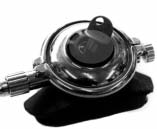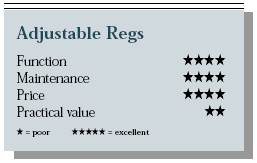Adjustable RegulatorsContents of this Issue: At the Edge of the World on the Pindito An Alternative to Shallow-Water Drowning Editorial Office: Ben Davison Publisher and Editor Undercurrent 3020 Bridgeway, Suite 102 Sausalito, CA 94965 A new twist? from the May, 1997 issue of Undercurrent
Although the equipment's been around for some time, current scuba equipment ads and catalogs are pushing new diver-adjustable second-stage regulators. They claim that the adjustment feature is a useful upgrade for divers who have other types of regulators or a worthwhile investment if you're a first-time buyer. I wondered: How much of this is hype? Are You Well Adjusted? To determine the usefulness of the adjustment knobs, I assembled a team of nine divers. For the most part, these divers provided their own regulators; I supplied an adjustable model to anyone who didn't have one. Scubapro offered me the use of a new G250, but to avoid a conflict of interest, I declined to use it (see sidebar); we used an old one instead. And I used an Impulse, a demo loaned to us by U.S. Divers' marketing department with no conditions attached. Divers were briefed on the features of the regulators, then told to try them out and report their impressions. How easy was each unit to breathe from? Which were the most comfortable? Which did they like best? Since my real purpose was to determine how useful the divers found the adjustment features, I used a little deception: I didn't ask them at the outset to evaluate this capability. Instead, I sprung the question after the testing was done. Why Adjust? When you inhale, you produce a slight vacuum in the regulator's second stage. This pulls the diaphragm in and lets air flow from the tank. (Pushing the purge button does the same thing.) Many divers, including all nine members of my test team and me, like the almost effortless breathing -- the low cracking pressure -- of the more highly tuned and sensitive regulators.
The problem is that a sensitive regulator sometimes delivers air when you don't want it. It can react to small changes in external pressure, such as when you're swimming through wave surge or strong currents. Manufacturers tout the adjustability feature as a way around this disadvantage. According to Scubapro's 1997 equipment selection guide, "detuning the valve slightly can improve breathing comfort under certain diving conditions, like being upside down. . . . [It] is also valuable when swimming into swift currents or plunging through strong wave action and surf." U.S. Divers' 1997 catalog says the adjustable valve "fine-tunes sensitivity: [it] enables diver to customize breathing characteristics to varying diving conditions." Superior or Superfluous? When I debriefed the divers and compiled the results, I got a big surprise. I had expected comments about the knobs being too small or hard to turn with gloves on. Instead, our testers mostly ignored the features. Russ: "Played with them before the dive, then never thought to open them later." Cory: "Didn't want to fuss with the knobs; didn't use them." John: "Easy to use, but more trouble than it was worth." Diana: "I was too absorbed in the dives to remember the knobs." Dan: "Liked the smaller regulators a lot; the adjustment knobs did not matter." Ron: "Hard to remember to use the knobs and levers, did not bother." Shirley: "Knew how, but never used them." Barbara: "Forgot to open them up when ready to dive after being on the surface." Tim: "Great on the entry -- set one before the dive, then forgot about it." Not one of the nine divers who were asked to evaluate their regulators during the dive even bothered to touch the adjustment knob once they were underwater! Certainly a result that favors superfluous over superior. Is the Upkeep More? Since they're more complex, you'd expect adjustable regulators to be more difficult and expensive to maintain. I compared otherwise near-identical adjustable and nonadjustable models from two manufacturers: Scubapro's adjustable G250 and nonadjustable G200B, and U.S. Divers' adjustable and nonadjustable Micras. In each case, the annual maintenance requirements, including parts, are the same for adjustable and nonadjustable models. Do adjustables cost more to service? Probably not.
In fact, adjustability offers some maintenance advantages. U.S. Divers' operating manual states that the Micra adjustable "should be stored with the adjustment knob turned all the way out. . . . This will extend the life of the low-pressure seat." Scubapro says, "The seat rests against a sharp orifice. . . . This causes the regulator to lose adjustment."
Relieving the pressure of the orifice on the seat definitely extends the life of the seat. Oldtimers will remember the plug they used to store in the cover to depress the diaphragm, thus pulling the seat from the orifice. Unscrewing the adjustment knob has the same effect. The trick is remembering to do it after each dive trip. To Buy or Not to Buy The adjustment feature gets four stars for function, maintenance, and price. The extra cost is reasonable; the adjustable feature only increases the cost by about 10 percent. There's no maintenance penalty, and it works fine. But I can give it only two stars for practical value because my sense is, based on our test dives, that most divers never bother to use it. Its biggest value is when you are out in the boonies, and your regulator develops a free flow, making a slight turn of a knob a lot more convenient than trying to find a service technician.
If you already have one or when you decide to pay a little more for an adjustable, keep three things in mind. If you remember to use the knob, it will add value to your high-performance regulator. If you don't, you're wasting money. And if you're a set-and-forget diver, you may, by detuning it, convert your expensive, top-of-the-line, highperformance regulator quickly and easily into an expensive, bottom-of-the-line, low-performance regulator. T. J.
|

I want to get all the stories! Tell me how I can become an Undercurrent Online Member and get online access to all the articles of Undercurrent as well as thousands of first hand reports on dive operations world-wide
| Home | Online Members Area | My Account |
Login
|
Join
|
| Travel Index |
Dive Resort & Liveaboard Reviews
|
Featured Reports
|
Recent
Issues
|
Back Issues
|
|
Dive Gear
Index
|
Health/Safety Index
|
Environment & Misc.
Index
|
Seasonal Planner
|
Blogs
|
Free Articles
|
Book Picks
|
News
|
|
Special Offers
|
RSS
|
FAQ
|
About Us
|
Contact Us
|
Links
|
3020 Bridgeway, Ste 102, Sausalito, Ca 94965
All rights reserved.




